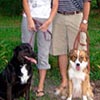
Reactive Rehab Full Service Training
The Reactive Rehab Full Service Program is designed to build your dog’s confidence through reliable obedience by properly addressing your dog’s fears and insecurities. Humans, sometimes inadvertently, can contribute to the majority of a dog’s fear issues. Often we try to “help” our dogs when they are scared or timid. We try to reassure our dog that the thunder storms, big garbage truck, the vet, dogs/strangers, or other noisy public places are not scary. People mistakenly do this by providing words of comfort (its OK), petting, holding, retraining, giving treats, avoiding situations, or even removing their dogs if they feel threatened. With the best intentions of helping your dog to become strong and confident, your actions instead could be reinforcing the dog’s state of mind you are trying to avoid. The Doghouse, LLC has rehabilitated numerous fearful/insecure dogs and we recognize this common handling mistake therefore, we can discern the necessary steps to stop this pattern.
Fearful and timid dogs need confidence and reliable obedience to help become secure and have a defined purpose. In our 3 week Reactive Rehab Full Service Program, your dog will learn a new skill set that is gained through healthy leadership. We train in numerous locations around town and deliberately put your dog in situations you are probably used to avoiding. Rather then trying to control the environment around the dog (which is impossible!), we will build a mutual trust and understanding your dogs thresholds and instead use our reliable obedience to handle the dog. Your dog will understand their purpose and how they fit not only into your lifestyle but more importantly into the ever changing world around them. Through patience, repetition, and exposure your dog will become more confident and have the security they desire in a confident leader.
The results of this program will also include any customized goals we discuss during the meet/greet, your dog being able to enjoy the benefits of just being a dog, and you having the confidence to handle your dog no matter what the scenario is by implementing the 9 basic obedience commands that are listed below:
All Full Service Programs include learning in the following 9 commands:
- Heel
- Automatic sit while heeling
- Sit
- Down
- Stay
- Door stays/car stays
- Come
- Place
- OK (the release command)
*For a detailed description of each command and the expectation please click here
Sit - In this exercise, the dogs behind must make contact with the floor. No hovering!
Down - In this exercise, the dog's elbows must touch the floor.
Heel - In this exercise, the dog should be in position on the left side (unless discussed otherwise during the meet/greet). Your dog's shoulder should line up with your knee, and the leash should be "loose" at all times.
Stay - In this exercise, you can leave the dog in a sit or a down position. The dog has to hold that position until you return to the dog and give the release. *You must never release the dog from the stay position if you are away from the dog. I want the dog to be clear about staying and coming. These two commands are opposite exercises. While in the stay, walk back to where you assigned the sit or down and give the release word "OK" to allow them to break the position.
Come - In this exercise, we wait until the dog is "free-roaming." Then, you say the dog's name and the COME command. The dog should stop what it's doing and come to you. The dog needs to be within a 1-yard radius of you and not leave until you give it the release command "OK."
Place - In this exercise, you assign your dog to a specific "Place." The definition of a place is anything that is elevated off the ground or has a texture difference. Examples are dog beds, Kuranda beds, park benches, and backseats of cars; you can be creative and challenge your dog! The same rules apply as in the stay position.
No - This command marks a behavior we want the dog to change.
Good - We tell our dogs this command to let them know they are doing what we want and that if they continue this behavior, they will be rewarded or eventually given the release command "OK."
OK - Release word to end any exercise.
Off - This command is used for jumping on people or furniture. If the dog's feet leave the ground, we will say NO OFF.
Out - To release a toy.
Enough - This is a command we use around the kennel for barking. If your dog is barking, Enough indicates you need the dog to stop.
Mannerisms your dog knows from the training without having to say a specific commands - Not bolting out of an opened door, not jumping out of the car when the door is opened, not rushing out of a crate when you open the door, sitting before meals, sitting to get their collar and leash put on, not jumping to great guests, not counter surfing/begging, not being overly pushy for attention. *All the unspoken behaviors that make a dog easier to live with!




